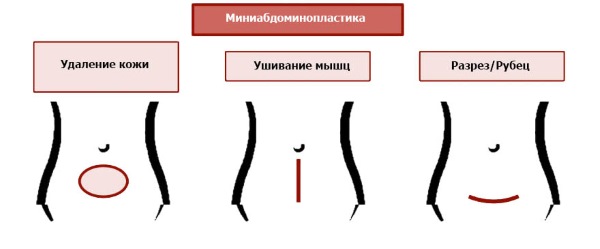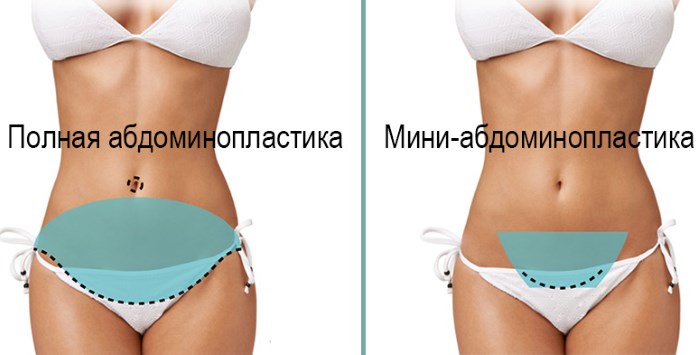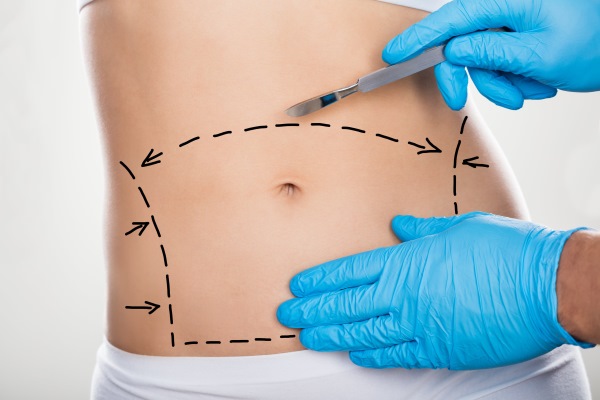Plastic surgery does not stand still. There are new ways to make people prettier, younger, more confident. One of these methods is abdominoplasty. What it is and what is the essence of the procedure, you can find out in the article.
Abdominoplasty - what is it, the essence of the procedure
Abdominoplasty is a volumetric surgery aimed at creating an aesthetic appearance of the anterior abdomen.
The purpose of the operation is to remove folds of skin and fat, eliminate stretch marks, restore the physiological position of the navel and loose abdominal muscles, as well as shaping a narrow waist and creating a slim silhouette.
Types of abdominoplasty of the abdomen
There are several types of abdominoplasty of the abdomen.
Mini abdominoplasty
Mini abdominoplasty is a limited tummy tuck that only affects the lower abdomen, without changing the position of the navel. This type of abdominoplasty is characterized by quick rehabilitation and a small incision line that will be invisible under the underwear.
Mini-abdominoplasty is divided into subspecies according to the method of its implementation:
In the umbilical technique, two small incisions are made around the navel. It is used to eliminate stretch marks and sagging skin.
Mini-abdominoplasty with an incision above the pubis above the hairline. The technique is applicable to eliminate defects in the part of the abdomen below the navel. Excess tissue is mobilized above the level of the navel, the muscles of the abdominal wall are sutured and excess tissue is removed. You can additionally carry out the procedure for strengthening the muscle corset.
Mini-abdominoplasty with de-epidermis of the skin. This option is less traumatic than the previous ones, since in this case only the surface layer of the skin is removed, and not the entire flap. It is used to eliminate minor defects.
Complete abdominoplasty (abdominoplasty)
Complete abdominoplasty (abdominoplasty) is performed with an abundance of subcutaneous fat layer, with abdominal hernias, in the presence of diastasis and stretch marks. The incisions are made around the navel and above the pubis. The size of the lower incision depends on the amount of fatty tissue.
Medium abdominoplasty (apronectomy)
Medium abdominoplasty (apronectomy) is also called media abdominoplasty. It is the middle link between mini abdominoplasty and complete abdominoplasty.
It is prescribed for patients with excess skin below the navel. During the operation, a vertical incision is made from the navel line downward and a horizontal incision along the bikini line.During the operation, a small amount of skin in the problem area is removed, the navel is moved and the abdominal muscles are sutured to eliminate diastasis.
Abdominoplasty with adipose tissue aspiration
Abdominoplasty with adipose tissue aspiration is recommended for patients with huge fat deposits on the abdomen and sides.
During the operation, adipose tissue is aspirated through special holes (liposuction), after which incisions are made in the navel and in the bikini area. A skin-fat flap is separated, excess skin is removed, the navel is shifted to an aesthetically correct position and diastasis is eliminated.
Vertical abdominoplasty
A vertical abdominoplasty is a complete tummy tuck. The doctor makes a vertical incision in the midline of the abdomen, and the doctor, at his discretion, can also perform a horizontal incision in the bikini area.
The vertical incision can reach the sternum line based on the patient's body fat. The abdominal muscles are sutured in the correct position (diastasis is eliminated), the navel is also fixed in the correct position, excess fatty tissue and sagging skin are removed.
Lateral abdominoplasty
Lateral or tension-lateral abdominoplasty is prescribed for patients with deformation of the anterior abdominal wall, its lateral regions and defects in the muscle layer (diastasis).
For a plastic surgeon who has chosen this type of abdominoplasty, it will be important to take into account that the tissues in the upper thighs and the torso itself are a single whole from an aesthetic point of view.
The incisions are located along the lateral lines of the abdomen. This technique is used to shape the waist. Tissue tension is formed in the lateral line, the angle between the vertical axis of the body and the direction of tension is 90 degrees.
Abdominoplasty with waist line
Abdominoplasty with waist line allows you to get a thin waist, even if it was absent before. To achieve this goal, it may be necessary to remove one or a pair of lower ribs.
Endoscopic abdominoplasty
Endoscopic abdominoplasty is useful for defects such as muscle divergence in the anterior abdominal wall. The operation is performed by piercing the skin around the navel and bikini area.
Using endoscopic techniques and a specialized camera, the abdominal muscles are isolated and sutured. Hernias are removed during the operation. As a rule, it is accompanied by liposuction. Endoscopic abdominoplasty is indicated only for 10% of patients in the age group under 40 years old, with elastic abdominal skin and moderate fat deposits and diastasis.
Extended abdominoplasty
The combination of a full tummy tuck and lateral liposuction is called an extended abdominoplasty because it is a surgical procedure in which the incision line, when performed, extends from the line above the pubis along the lateral line towards the thigh bone. The incision line reaches the buttocks. As a result, the skin on the thighs, waist and the ilium is tightened.
Peripheral abdominoplasty
Combination of an extended abdominoplasty with a buttock lift. This operation is indicated for those who have a huge "apron" of the skin as a result of strong weight loss. A circular incision is made from the bikini line to the buttocks, and excess skin and excess fatty tissue are removed.

 Don't miss the most popular column article: Alentova Vera after plastic surgery - the last photos, what operations were performed, how the star changed.
Don't miss the most popular column article: Alentova Vera after plastic surgery - the last photos, what operations were performed, how the star changed.Indications for the operation
- fat and skin apron, pronounced folds on the abdomen;
- prolapse (ptosis) of the anterior abdominal wall;
- excess fatty tissue under the skin of the anterior abdominal wall, if it is impossible to eliminate these defects by conventional methods (diet, sports, cosmetic procedures), surgery, such as liposuction, or a combination of these methods;
- the presence of stretch marks (striae);
- stretching and divergence of the abdominal muscles;
- unaesthetic and rough postoperative sutures;
- hernia of the abdominal wall;
- loss of skin elasticity (when liposuction is not applicable).
Contraindications and restrictions
Abdominoplasty operation is categorically contraindicated if the patient has at least one of the following points:
- diabetes;
- oncology;
- dysfunction of the thyroid gland in a serious form;
- allergy to medicines;
- scars left after operations located above the level of the navel;
- in case of malfunction and diseases of the hematopoietic organs;
- the presence of mental disorders in the patient;
- renal failure, rheumatism;
- hypertension;
- 2,3,4 degrees of obesity;
- severe diseases of the cardiovascular system;
- varicose veins in the lower extremities;
- connective tissue diseases;
- AIDS, HIV, hepatitis;
- planning pregnancy in the first year after surgery and pregnancy at the time of the surgery.
In addition to the above general prohibitions on the operation, there are local contraindications:
- the presence of psoriasis,
- purulent pathologies,
- fungal infections of the skin,
- dermatitis,
- taking drugs that affect blood clotting.
Time restrictions for the operation:
- FLU, ARVI and other infectious diseases,
- chronic diseases during an exacerbation,
- menstruation in women (3-5 days before and after the tummy tuck)
Preparation for surgery (analyzes, regimen)
To obtain permission for plastic surgery, you need to pass the following tests:
- general blood analysis,
- general urine analysis,
- blood chemistry,
- blood clotting test, coagulogram,
- analysis for HIV, AIDS, hepatitis,
- determination of the group and Rh factor of blood.
Undergo instrumental diagnostics:
- fluorography,
- ECG.
After passing all the mandatory tests and examinations, you need to undergo medical examination with the following specialists:
- Therapist,
- Dentist.
Consultation with an anesthesiologist. The next stage of preparation for surgery is a consultation with an anesthesiologist. The anesthesiologist bears great responsibility for the patient's life, and therefore, having studied all the results of tests and examinations, he can prescribe additional ones.
These most often include 24-hour ECG, 24-hour pressure monitor, specialist consultations.
Consultation with a surgeon. After analyzing the summary drawn up by the anesthesiologist and examining the examination data, the surgeon will assess the following patient parameters:
- skin elasticity,
- the state of the muscular system,
- how pronounced is the subcutaneous fat layer,
- is there a need to move the navel,
- determination of the degree of ptosis,
- determination of the presence of hernias and defects.
At least 2-3 weeks before the start of the operation, the patient must adhere to a special diet and lifestyle regimen:
- To reduce the volume of the intestines and stomach, it is worth eating in small portions 4-6 times a day.
- Stick to separate meals.
- Do not drink food.
- Drink a glass of water shortly before a meal.
- Eat in small portions.
- Drink more than 2 liters of clean water per day.
- After 18:00, eat low-fat dairy products (cottage cheese, kefir, yogurt).
- It is recommended to take sorbents (Lactofiltrum) and preparations that normalize microflora (Linex, Bifiform, Acipol).
- Increase the level of activity, add exercise, aerobic or cardio loads to the daily schedule.
- Visit the bathhouse or sauna once a week.
- Visit the massage parlor and do body wraps to speed up metabolism.
- The diet before the procedure should be as limited as possible in carbohydrate intake. Sweet, flour, salty, smoked, fried, fatty foods, pasta, potatoes, sausages, sweet fruits (bananas, grapes), ketchup, mayonnaise and other unhealthy foods are excluded from the diet.
- Start taking drugs that strengthen the walls of blood vessels (Detralex, Ascorutin).
Before surgery, a few days before:
- Smoking cessation is recommended, as blood circulation deteriorates, which contributes to poor healing of stitches.
- It is necessary to carefully carry out the prevention of colds and infectious diseases, to prevent ailments.
- Alcoholic drinks should be excluded a week before the operation.
- Any medication you take should be discussed with your doctor. Preparations based on aspirin, ibuprofen thin the blood and should be excluded a week before surgery,
- On the day before surgery, until midnight, only light food and liquid should be included in the diet. You should refuse food intake six hours before the operation itself, and fluids two hours before. It is better to drink 200 ml of tea, coffee or water in the morning before the operation,
- On the day of the operation, do not use cosmetics and decorative nail polish.
- Jewelry and piercings should be removed and left at home.

 Don't miss the most popular column article: Cannula - what is it, how is it used in cosmetology and medicine.
Don't miss the most popular column article: Cannula - what is it, how is it used in cosmetology and medicine.How is the operation performed
The duration of the operation is from two to five hours, depending on the selected type.
Abdominoplasty is performed using general anesthesia (general anesthesia), in some cases, local anesthesia can be used, combined with sedation, in which the patient is conscious and may experience discomfort.

- Marking is applied to the patient's skin. It will help the surgeon navigate the amount of tissue to be removed and be sure of the correct actions so that the body is symmetrical, and the seam looks aesthetically pleasing and does not overtighten. The markings are applied to the patient's skin while standing.
- The cut is made. The incision is above the pubic hairline and is usually 5-6 cm long, as determined by the plastic surgeon. The classic incision can be supplemented or replaced with a vertical incision or incisions around the navel. The choice is determined by the amount of the patient's subcutaneous fat layer.
- Separation of fat and skin tissue from the abdominal wall is performed.
- Muscles and connective tissues are fixed in the correct position, if necessary.
- Hernias are repositioned and sutured, fixed using a medical mesh.
- Liposuction is performed if necessary.
- A new umbilical ring is formed.
- Excess skin and fat are removed.
- The incision is closed using specialized glue or by suturing.
- After the end of the operation, the seam is treated with an antiseptic and closed with a sterile bandage, after which a special compression garment is put on.
Rehabilitation after abdominoplasty
Such a voluminous surgical intervention as abdominoplasty provides for a long recovery period, which usually lasts six months. The first 4-6 weeks of this period are the most difficult for the patient.
During the first 3 days after plastic surgery, the patient must be in the hospital under the supervision of medical personneland, after which, with good health, no complaints and good condition of the seam, he can be discharged home. In some cases, patients are kept under observation for a longer period.
On average, the picture of the recovery period in the first days after the operation looks like this:
On the first day, you can only lie down. A lying position with the head of the bed raised is allowed. From food you can only water (ordinary or mineral without gas), after the restoration of intestinal function, they give light food,
On the second day, the patient tries to get out of bed. This task for the first time is feasible only with the help of medical staff, so as not to harm health. The patient is allowed to drink fluids without restriction and eat light food. The temperature may rise slightly.
After removing the stitches, a special course of rehabilitation procedures is recommended, which include apparatus massage and physiotherapy.Special gymnastics is also recommended, which will not allow the muscles to atrophy.
To maintain the tissue in good shape, it is mandatory to wear compression underwear, which keeps the seams from diverging. For 3 months, it is forbidden to visit baths, saunas, take hot baths, play sports, physical labor should also be reduced as much as possible.
Sex is prohibited until the doctor allows you to remove the postoperative underwear. This period can last from one to three months and the end of it does not mean that it is worth immediately catching up. Intimacy in the first time after surgery should be treated as physical activity.

 Don't miss the most popular column article: How and why ribs are removed - efficiency, photos before and after surgery.
Don't miss the most popular column article: How and why ribs are removed - efficiency, photos before and after surgery.Mode
In order not to nullify the work of a plastic surgeon and not to waste money spent on the operation, it is imperative to observe the diet.
After surgery, it is important for the body to find energy to restore and maintain immunity. Proper nutrition during this period will help to avoid complications after abdominoplasty surgery. This is what the right diet is after an abdominoplasty:
- In the first week, it is important to limit the consumption of foods that contribute to gas formation (grapes, legumes, carbonated water, kvass, cabbage).
- It is necessary to monitor the amount of fluid consumed and not exceed the limit set by the doctor.
- Nutritionists advise to stick to fractional meals when you return home. This diet will reduce stomach volume and help you gradually lose weight without harming your body. The habit of eating small portions of 200-250 g 5-6 times a day and counting 300 kcal per serving will help preserve the result of the operation for a longer period.
Foods that will help restore the body after abdominoplasty:
- meat, fish, steamed or boiled, dried fruits, eggs help accelerate the healing of scars;
- raisins, buckwheat, beef, liver saturate the body with iron and increase the level of hemoglobin;
- citrus fruits, apples, persimmons, tomatoes, bell peppers are rich in vitamin C and help to accelerate the healing of scars.
After the operation, you should avoid fast food restaurants, pickles, fatty, smoked, fried.
Care of the seam condition
Skin sutures after abdominoplasty are removed on the fourteenth day. If an intradermal suture has been applied, then its removal is not required, since when it is applied, materials that dissolve themselves or special glue are used.
The seam must be treated with antiseptic agents (alcohol, brilliant green), at least twice a day. Also, the seam is not allowed to get wet in the first 5 days. On days 6-7, it is allowed to take a full shower, carefully avoiding soap and water on the incision area.
By the time the suture is removed, the hematomas disappear, edema can be present up to six months, only after their complete recession can the result of the operation be fully evaluated.
Compression garments after abdominoplasty
Compression garments after abdominoplasty should be made from specialized breathable materials and purchased from a pharmacy or specialty store. It should provide support and comfort by distributing pressure evenly throughout the surgical site.

After the tummy tuck, the postoperative underwear is put on immediately, it reduces swelling and prevents bloating, supporting the tissues... Plus, wearing compression garments helps control appetite by keeping it tight to your stomach.
Wearing such underwear will help to reduce not only tissue swelling, but also improve the scarring process, reduce the risk of complications and improves blood circulation. Supporting the tissues in the correct position will help maintain the result of the operation during the healing process.
Surgeons recommend wearing postoperative underwear around the clock for 2 or 3 weeks, in some cases 4-6, depending on the volume of surgery. In the case where the elimination of diastasis (divergence of the rectus abdominis muscles) has not taken place, it is enough to wear this underwear for three weeks.
In order for clothes to be useful, they must be chosen correctly. Compression garments should be sized appropriately and soft enough to avoid injury and the formation of contoured skin irregularities.
It is important that the underwear has a system of adjustable fasteners in order to control the level of compression during the healing process.
Spandex and nylon are used for quality compression garments. The fabrics must be strong and antimicrobial, allowing the skin to breathe. Since the underwear can take up to six weeks of continuous wear, it is worth preparing several sets.
Compression of not only the abdomen and thighs, but also the legs may be needed, so it is worth preparing and stocking up on compression stockings. The size and shape of the compression garment will help the surgeon choose, based on the volume of the surgical intervention.
Consequences and complications. Swelling after abdominoplasty
- In the first hours after the operation, edema appears. They may get stronger in the first week and not subside completely for several months.
- Superficial hematomas are common after abdominoplasty. They come off quickly and leave no traces.
- Postoperative incisions leave scars that can be hidden with any underwear or swimsuit. The use of ointments and special cosmetic procedures will help make them less visible or completely invisible, but the methods of modern plastic surgeons allow the scar to become an invisible light streak after six months.
- Loss of sensitivity in the area of the performed operation is possible for up to six months, after which it will recover in full. During this time, the patient will feel numbness when touching the suture area.
The following complications may occur after surgery:
- Blood or tissue fluid may accumulate in the seam cavity. To avoid this complication, a drainage procedure is performed, during which thin tubes are inserted under the skin into the incision area.
- The appearance of inflammation in the area of a wound formed during surgery is most often observed in patients with a high degree of obesity. For prevention, antibacterial drugs are prescribed after surgery, which are aimed at a wide range of actions.
- The divergence of the seams is possible with physical exertion and skin suppuration, after which unwanted scars may appear.
- Death of the edges of the sutures can occur if there are already scars in the area of the operation from previous surgical interventions or if the edges of the wound were overtightened. To eliminate this defect, surgical intervention will be required.
- The accumulation of adipose tissue above the suture level is possible with a strong downward displacement of the tissues and with an impressive thickness of the subcutaneous fat layer. To eliminate the seal in the form of a roller, one more surgical intervention will be required.
- Chronic pain syndrome is quite rare. This complication is not treated, but only temporarily drowned out by taking painkillers.
- Asymmetry occurs when the abdominal muscles and their connective tissues are not properly fixed. It is eliminated in three ways: filling with own fat, drugs with hyaluronic acid or surgery.
- Skin hyperpigmentation can occur at the site of subcutaneous hematomas.
Abdominoplasty and subsequent pregnancy
Pregnancy after abdominal surgery is not desirable for one year.As well as after the abdominoplasty operation, because it can provoke such consequences as the appearance of stretch marks, skin laxity and diastasis.
When to start exercising
Six weeks after the operation, you can start walking, jogging, and light exercises. Movements should be smooth and light.
Strength loads and heavy physical exercises are contraindicated at this stage.
If you feel well, you can go to the gym, but the exercises should be performed only in compression underwear. A full recommendation regarding physical activity is given by the doctor individually, after the operation.
How much does an abdominoplasty cost - price
The cost of an abdominoplasty depends on its type. The more extensive the operation, the more expensive it will be. The price of an abdominoplasty varies on average from 80,000 rubles to 200,000 rubles, the cost of the operation usually does not include the delivery of tests and consultations of doctors.
The cost of an abdominoplasty operation consists of the cost of the operation itself, anesthesia, hospital stay (price per room), compression underwear, rehabilitation procedures, dressings and follow-up after the operation.
Conclusion
In conclusion, we can say about the abdominoplasty operation, that it is such an operation, which is aimed at making people more beautiful, as in most cases it happens. Therefore, it is extremely important to follow all the doctor's recommendations aimed at maintaining a new appearance.
Videos: what is abdominoplasty
The plastic surgeon will answer the question "what is abdominoplasty":
Everything you need to know about abdominoplasty:





My saggy stomach still did not want to leave after childbirth, neither diet nor sports helped. I decided to undergo abdominoplasty. Now the tummy is beautiful and flat, and the postoperative hardships were quickly forgotten when I saw such a result !!!
I wanted a slim figure, like a girl's. I read about the operation on the Internet, looked at the photo - it is tempting ... Thanks to the surgeon for his golden hands. I do not regret it at all! Six months have passed, and now I like my figure again.
Thanks to this miracle, I again feel confident in an open swimsuit on the beach, in revealing underwear. Now I can wear tight clothes, which I have never dreamed of.
The exact cost of the operation can be calculated only after a personal consultation with a doctor. The price of an abdominoplasty procedure consists of many factors, but in any case, the cost of this operation for a good surgeon starts from 180-200 thousand rubles.
Abdominoplasty was done by Sergey Petrin in Moscow. Parted with a big belly forever. Yes, strictly I went with me, went under the knife, but wearing it on myself is also not very good for my health. After the operation, it became easy and beautiful, and the joy returned. I don’t regret a bit, along with liposuction of the abdomen and sides, the abdomen became even and flat without stretch marks and excess skin. I am 48 years old, I am a mother of 2 adult children